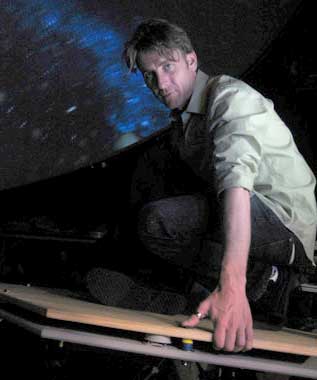Recent News
New director will enhance interdisciplinary engineering learning opportunities
July 2, 2025
Final SIRI cohort visits UNM campus
June 30, 2025
Perfetti receives ANS Landis Engineering Achievement Award
June 26, 2025
Engineering a new treatment for ovarian cancer
June 24, 2025
News Archives
Hexdex Takes Gaming to New Dimensions
November 14, 2011
 Imagine you’re immersed – virtually – in the rings of Saturn. The ship moves with your body, reacting subtly yet swiftly. Armed with a remote control and your talent for dodging flying objects without losing your balance, you blast through asteroids hurtling past on all sides. One speeding chunk of ice escapes your notice, hits with a crack. Spidery veins branch across the glass, and you’re thrown clear of the ship.
Imagine you’re immersed – virtually – in the rings of Saturn. The ship moves with your body, reacting subtly yet swiftly. Armed with a remote control and your talent for dodging flying objects without losing your balance, you blast through asteroids hurtling past on all sides. One speeding chunk of ice escapes your notice, hits with a crack. Spidery veins branch across the glass, and you’re thrown clear of the ship.
Except for playing at the gentler level – the one without the throwing – that was this writer’s experience trying the hexdex. The research project by Joe Kniss, assistant professor, Department of Computer Science, (photo), and interdisciplinary collaborators at the University of New Mexico was featured on the Discovery Channel’s Daily Planet.
Education has been core to the project. After Kniss and a mechanical engineering colleague designed and built the first hexdex, graduate students built the second from start to finish under Kniss’ supervision.
 “Every aspect of standing that up, making it work, making it dance – a student had a hand in that,” he said.
“Every aspect of standing that up, making it work, making it dance – a student had a hand in that,” he said.
Kniss said the platform is similar to what’s used in NASA flight simulators, but on a smaller scale. The hexdex is a six-sided platform supported by six arms allowing movement with six degrees of freedom: up/down, left/right, front/back, twist, pitch and roll. Two hexdexes are set inside a larger platform that rotates while maintaining the hexdexes’ orientation. The platform interacts with a dome or other supersized screen, immersing the player in the action. A remote control provides additional functions, like shooting and acceleration.
In passive mode, the hexdex moves with the player. For example, in the asteroids game, the player shifts his weight to rotate the view. When playing in active mode, the hexdex also responds to what’s happening on the screen, for example by pitching the player off when he hits an asteroid.
Kniss’ main interest in the project is as a scientist and researcher. Even the games have scientific elements. For example, the environment of the asteroids game was created using NASA Cassini spacecraft footage from a mission to Saturn moon Titan.
The research is also part of a larger UNM ARTS Lab project in interactive dome applications funded by the National Science Foundation’s Partnership for Innovation. Domes, known popularly for their use in planetariums, have many applications, such as scientific simulations and immersive art. ARTS Lab has a small dome for experimenting.
Innovation works in mysterious ways. Kniss started developing the hexdex because he missed skateboarding and snowboarding in Idaho, where he grew up and where the powdery snow provided soft landings in case of accident. He said the hexdex has “the feel and fun of skateboarding without the road rash, without the broken bones.”

 Related Content
Related Content